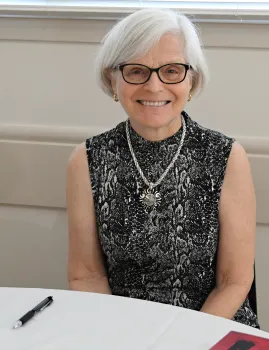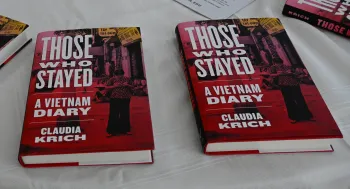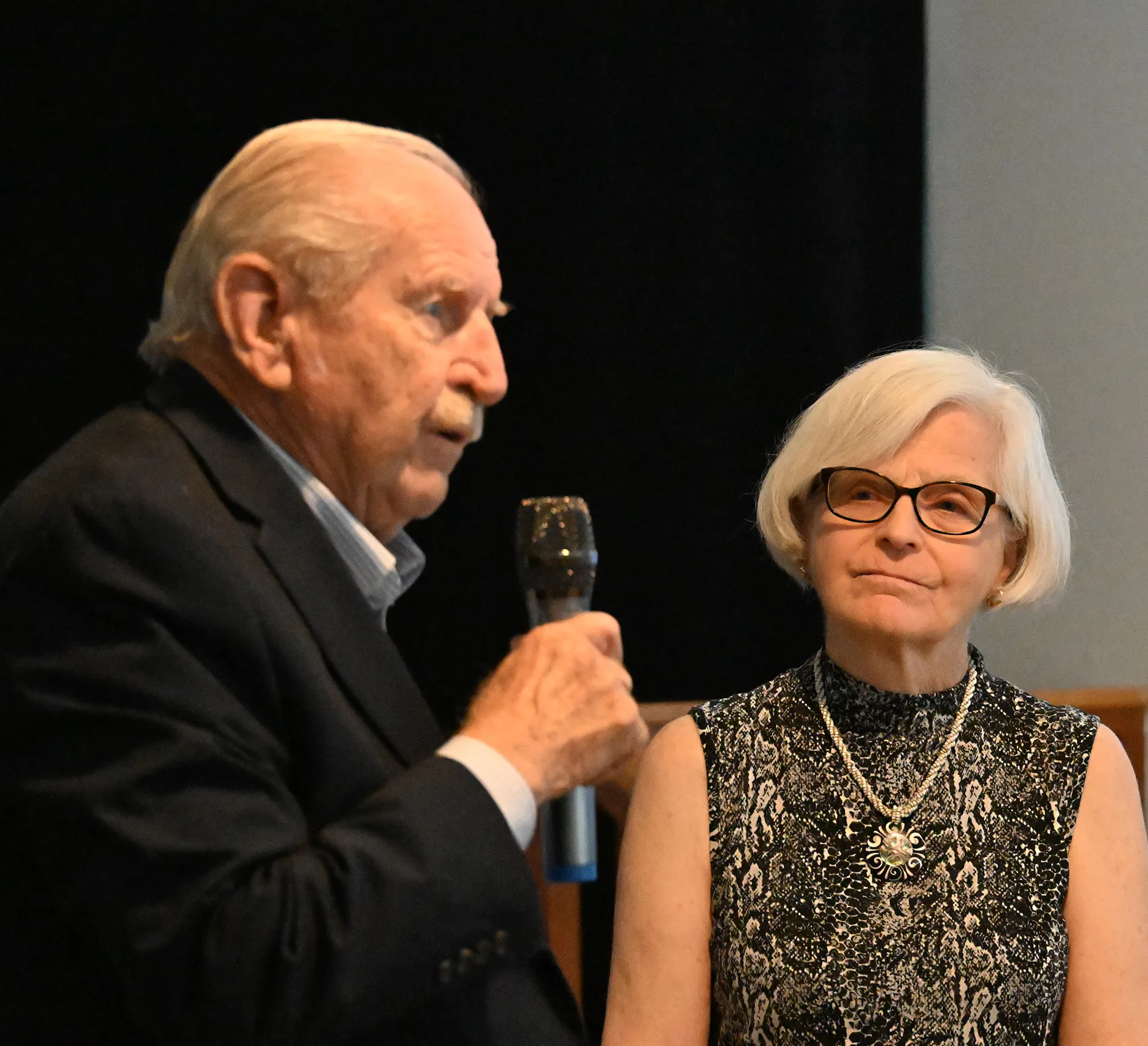
"It was a peaceful transition, and not the expected bloodbath."
That's what retired teacher Claudia Krich of Davis, author of "Those Who Stayed: A Vietnam Diary," and an eyewitness to the Fall of Saigon told a recent meeting of the Vacaville Museum Guild.
That day, April 30, 1975, marked the end of the Vietnam War, she said, "or what the Vietnamese called the American War."
Introduced by retired teacher Pat Zetah, president of the Museum Guild, Krich related that she and her husband Keith Brinton, co-directed a civilian rehabilitation program, the American Friends Service Committee (AFSC) medical relief program in Quang Ngãi. near My Lai, in central Vietnam from early 1973 to July of 1975.
"Quang Ngãi was controlled by the Saigon government during the day, and the Liberation Front at night," Krich said. Fifty-five Vietnamese, and 5 non-Vietnamese staffed the AFSC rehab center. "Our rehab center served hundreds of injured civilians from all sides of the conflict. Most were amputees, and most injuries were caused by land mines."
When the South Vietnamese government began to crumble in April of 1975, Krich and a few other humanitarian aides headed to Saigon to witness the transition. April 30, 1975 was peaceful, she reiterated, and not a "bloodbath of maim, mutilation, murder and torture." Both sides of the wartorn country, she said, were glad the war was over.
Throughout her work in Vietnam, Krich kept a diary that evolved into the April 2025 publication of her 304-page book. The book, published by the University of Virginia Press, also includes her images and short pieces by others with first-hand knowledge of what occurred.
Mosquitoes and Malaria
Since this is a bug blog, let's turn to mosquitoes and malaria, and her experiences.
The malaria mosquito is considered the world's deadliest animal; it transmits the malaria parasite, Plasmodium. Worldwide, each year malaria infects some 290 million people, and more than 400,000 die of the disease, according to the Mayo Clinic.

"The insect I most remember is definitely the dangerous common mosquito," Krich related. "We always slept inside mosquito nets, both in our town, Quang Ngai, and in Saigon, and we used repellent, and our team doctor shot us with gamma globulin in our behinds every month. I don't think it was terribly effective, but I at least did not get malaria. I did, however, get dengue fever, also caused by mosquitos, and viral rheumatoid arthritis, which mosquitoes can contribute to. I didn't get hemorrhagic fever, also carried by mosquitoes, but other people did. One day one of our workers said goodbye to his little boy, I think about 6 years old, in the morning, and that child was dead before lunch, from an extreme case of hemorrhagic fever. He bled to death. It was horrific."
"I would imagine that all the chemicals we dropped probably lowered the overall insect count in South Vietnam, but I don't really know. I know we never saw any large geckos, because they lived in trees in the jungle and many had been killed by the defoliants and the lack of foliage. They would have helped by eating mosquitoes. We only saw the cute little geckos that lived in our houses. They ate mosquitoes and flies, and even each other, but they didn't eat as many insects as the big geckos would have."
During the Vietnam War, 46 U.S. military personnel died of malaria, according to "History of Nalaria in the United States Naval Forces at War: World War I through the Vietnam Conflict," research published in 1993 in the journal Clinical Infectious Diseases. Statistics show that during the Vietnam War, "there were 24,606 cases of malaria, and an estimated 391,965 sick-days because of malaria."
As an aside, the Anopheles mosquitoes that transmit malaria are present in California, "but the parasites that cause malaria are not currently found in these mosquitoes in California," according to the California Department of Public Health. "The last cases of local transmission of malaria in California were reported in 1989. About 100 cases of malaria are reported each year in California from people who were infected while traveling in other countries."
And dengue? It's surfaced in California, but "Nearly all dengue cases reported in California have been associated with exposure through travel to an area affected by dengue outside of California." (See chart).

During the discussion that followed Krich's talk, former Vacaville Mayor Len Augustine, a Vietnam veteran and a retired U.S. Air Force colonel, briefly shared a different perspective of the transition and the Vietnam War. As a pilot, Augustine flew into remote airfields "that would quickly come under attack." During his military career, he served as the commander for the 89th Military Airlift Wing Command, responsible for all operations, maintenance, and transportation of the Presidential Wing of the U.S. Air Force, including the safe, reliable operation of Air Force One.
In denouncing the war, Krich questioned: "For what?"
According to Wikipedia, "The war exacted an enormous cost: estimates of Vietnamese soldiers and civilians killed range from 970,000 to 3 million. Some 275,000–310,000 Cambodians, 20,000–62,000 Laotians, and 58,220 US service members died...20% of South Vietnam's jungle was sprayed with toxic herbicides, which led to significant health problems,"
Of the Krich book, reviewer John Balaban, author of "Remembering "Remembering Heaven's Face: A Story of Rescue in Wartime Vietnam," wrote: "Claudia Krich was a Quaker volunteer in a particularly dangerous province during our war in Vietnam. Speaking Vietnamese, she kept a sharp eye and a carefully detailed diary. Instead of fleeing home to the U.S. when the North took Saigon, she stayed to bring us this amazing look into that revolution."
Activist Craig McNamara, author of "Because Our Fathers Lied: A Memoir of Truth and Family, from Vietnam to Today," opined in his review of Krich's book: "A gripping first-hand account of life in Saigon after the American withdrawal. In intimate detail, the author shares her personal and historical story of the American War from an insider perspective. While in America little or nothing was known about what happened in Vietnam after the U.S. pulled out, in Vietnam the end of the war signaled the beginning of peace and recovery."
Why did Krich write the book? In an interview with her book publisher, she said: "When I watched the Ken Burns/Lynn Novick Viet Nam documentary I was surprised and upset that it ended without telling what happened in Viet Nam after the Americans left. They had no interviews with any of the dozen or so of us Americans who stayed. It left viewers with the impression that the prediction by the U.S. and South Vietnamese government that there would be a bloodbath in Viet Nam was true. I decided to finally turn my Viet Nam diary from 1975 into the book I’d planned for nearly 50 years, to set the record straight about what really happened."
(Cover image on this blog is of Anopheles gambiae by research entomologist Anton Cornel of the Kearney Agricultural Research and Extension Center and UC Davis Department of Entomology and Nematology).

